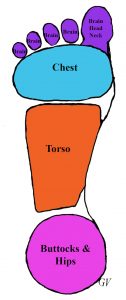 Feet are very resilient and deserve great respect for all they do for us. Weighing only two percent of our total body, these small appendages have herculean strength, capable of bearing tremendous stress and weight- in fact according to the late Osteopathic Doctor, John Martin Hiss, the ligament structure of feet can withstand the weight of 7860 lbs per square inch. Dr. Hiss also noted feet are extremely adaptable and have a vast range of portability, equipped to perform 150 variations of positions to allow for a wide variety of spontaneous movements.
Feet are very resilient and deserve great respect for all they do for us. Weighing only two percent of our total body, these small appendages have herculean strength, capable of bearing tremendous stress and weight- in fact according to the late Osteopathic Doctor, John Martin Hiss, the ligament structure of feet can withstand the weight of 7860 lbs per square inch. Dr. Hiss also noted feet are extremely adaptable and have a vast range of portability, equipped to perform 150 variations of positions to allow for a wide variety of spontaneous movements.
After working as a Reflexologist for 38 years I have become convinced feet are a microcosmic equal to the body. When one asks “How can you know toes are related to the head and sinuses?”or “How can you know the hip is connected with the base of the fifth metatarsal?” and so on… In my earlier years of practicing reflexology I didn’t really know, but held faith in my practice because of positive health changes clients reported after receiving reflexology. In the beginning I followed a rudimentary reflexology map that assigned organs and glands to the body. I felt validated by my work when clients confirmed specific textures I noted on their feet to be associated with that part of their body. However, as I matured in my practice revelations provided more depth and credit to the science of reflexology measured by how feet bear weight and move the body.
It became clear that feet take their shape and function to accommodate the stature and movement of each individual and in my opinion this realization substantiated a basis of why I believe reflexology works. Furthermore, evidence supports an interrelationship between the feet and the body such as when a foot based ailment interferes with foot function-the body begins to hobble and becomes ineffective too. What happens to the feet happens to the body. Here are some associations of how parts of the feet are reflected in the body using a Harris Ink Mat.
The toes=the head and sinuses
If issues arise with the great toe foot mechanics are affected and the head becomes vulnerable and heavy because the action of the great toe is to provide a stable foundation for the head once weight reaches this part of the foot. I have come to expect that if one has weakness in their toes, a sinus issue ensues. Many of my clients think I’m psychic to be able to pick up on this but the truth is I understand the physiology of toe function and their combined strength plays an integral role in keeping balance for the head and neck as well as provide efficient lymphatic drainage for the sinuses.
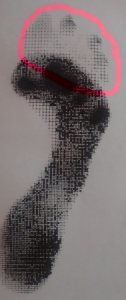
Print of a client who complained of sinus and balance issues. The slight impression of the toes show a lack of use (understimulated).
The balls of the foot= the chest and organs within, and diaphragm
Matters that present in the balls of the foot (often noticeable by calluses) translates to a weight distribution problem that is creating a burden to the joints that flex and extend the toes, and subsequently weakening the integrity of muscles that make up the pad of the forefoot. Normally this fleshy part of the foot cushions the impact of weight however, when weight is directed too quickly the forefoot makes abrupt contact with the ground causing the necessity for calluses to develop to protect the underlying structure. This abrupt impact is equally felt in the chest and diaphragm giving rise to health issues such as asthma, and other respiratory related events as was confirmed by the client of the foot print below.
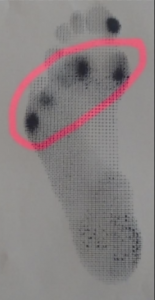
The mid-section of the foot=the waist of the body
The mid-section of the foot, specifically the bones of the transverse arch, act as a bridge to transfer weight from the outer column of the foot to the toes. If issues arise in any one of the four bones that make up the transverse arch, such as a locked joint or misalignment weight transfer will be ineffective and this will affect the mid back as well as manifest general irritation along the transverse colon and hips. Digestive issues such as constipation or the opposite, diarrhea will probably arise before any noticeable foot problem.
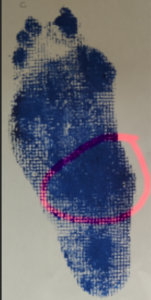
The individual of this print complained of back pain and acute digestive issues who underwent a partial colectomy a week later.
The heel of the foot=the pelvis
The heel, also known as the calcaneus is the largest bone in the foot and is associated with the structural component of the pelvis and the organs within. Heel spurs indicate strain in muscles that attach to the calcaneus leading to heel misalignment. If the heel bone becomes misaligned the pelvis will lose its foundational stability and one may complain of ailments related to the reproductive system, low back or sacroiliac joint.
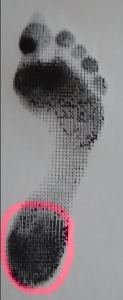
Print of a client complaining of foot and hip pain
Feet in a nut shell, are perfectly designed to carry and move the body. When feet become unable to perform normal function other parts of the body will be relied upon to do their job of propelling and balance. Prolonged periods of destabilized foot posture may eventually cause inflammation and in some cases acute degeneration in the feet and body. Once foot integrity is restored the upper body will relax and heal too, and the feet will once again become entrusted to do their intended job.
How well do your feet carry your body?
For better health and vitality read more here:
Put Your Best Feet Forward
Archives
- October 2024
- December 2023
- October 2023
- March 2022
- July 2021
- August 2020
- May 2020
- April 2020
- February 2020
- January 2020
- December 2019
- November 2019
- October 2019
- August 2019
- June 2019
- May 2019
- April 2019
- January 2019
- December 2018
- October 2018
- September 2018
- July 2018
- June 2018
- April 2018
- February 2018
- December 2017
- November 2017
- October 2017
- September 2017
- August 2017
- July 2017
- June 2017
- May 2017
- April 2017
- February 2017


